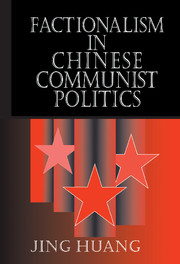Book contents
- Frontmatter
- Contents
- List of Figures and Tables
- Preface
- List of Abbreviations
- Introduction
- 1 Factionalism, the Puzzle of Chinese Communist Politics
- 2 Factionalism and the Political System in China
- 3 The Establishment of the Yan'an Round Table
- 4 The Transition of the Yan'an Round Table
- 5 Crises in Leadership Relations with the Two-Front Arrangement
- 6 The Collapse of the Yan'an Round Table and the Unleashing of Factionalism
- 7 Deng Xiaoping's Dominance: Factionalism Prevails over the Party Spirit
- 8 Conclusion
- Selected Bibliography
- Index
1 - Factionalism, the Puzzle of Chinese Communist Politics
Published online by Cambridge University Press: 11 September 2009
- Frontmatter
- Contents
- List of Figures and Tables
- Preface
- List of Abbreviations
- Introduction
- 1 Factionalism, the Puzzle of Chinese Communist Politics
- 2 Factionalism and the Political System in China
- 3 The Establishment of the Yan'an Round Table
- 4 The Transition of the Yan'an Round Table
- 5 Crises in Leadership Relations with the Two-Front Arrangement
- 6 The Collapse of the Yan'an Round Table and the Unleashing of Factionalism
- 7 Deng Xiaoping's Dominance: Factionalism Prevails over the Party Spirit
- 8 Conclusion
- Selected Bibliography
- Index
Summary
CONFLICT MODELS AND THEIR EXPLANATIONS OF FACTIONALISM
From Unity to Conflict
Factional politics is a politics of conflict. Before the Cultural Revolution (CR) unfolded in 1966, factionalism was barely noticed in the study of Chinese politics because the field was predominated by unity analyses. These analyses see Chinese politics as a united entity, integrated by ideology and organizations, maintained by discipline and a strong leadership, and safeguarded by the People's Liberation Army (PLA) commanded by the Party.
A totalitarian model was applied in the 1950s and the early 1960s. As Oksenberg points out, this model stresses the Soviet-like qualities of the CCP regime: “the adherence of its leaders to Marxism-Leninism, the totalitarian grip of the top political leaders upon the entire society and culture, and the centrally planned economy in which resources were allocated through political command”. Ironically, this description corresponds to the CCP's nostalgic view, which sees the initial years of the PRC as “a period not only when the Party's policies were usually correct, but also when leadership relations were marked by a high degree of unity and democracy”.
Indeed, this was a period of startling accomplishment for the CCP: a Stalinist system was established, the confrontation with the hostile forces led by the United States in the Korean War boosted national confidence, the economy recovered and was molded into the Soviet central-planning model with an astonishing speed.
- Type
- Chapter
- Information
- Factionalism in Chinese Communist Politics , pp. 26 - 54Publisher: Cambridge University PressPrint publication year: 2000



